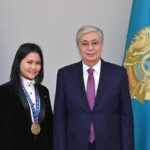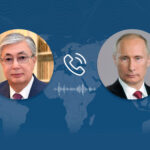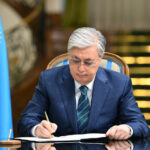In 1953, Sir Olaf Kirkpatrick Kruuse Caroe (1892-1981) published an essay in the Foreign Affairs Magazine (USA) called “Soviet Colonialism in Central Asia”. The article below is a summary of that publication.
The author was one of the administrators of British India in the first half of the 20th century, serving as the governor of the North-West Frontier Province. Following the dissolution of the British colonial system, he emerged as an authoritative writer and publicist, specializing in a wide range of issues related to Asian history, development, and geopolitics. Olaf Caroe hailed from the renowned Anglo-Saxon tradition of aristocrats, conquerors, colonizers, and rulers of subjugated peoples. He approached the question of the collectivization and industrialization of the Kazakh steppe with competence and systematic analysis.
Olaf Caroe is said to have had highly influential ideas about the future, earning him a reputation as an expert in dealing with nomadic peoples. His ideas were utilized by both the United Kingdom and the United States in their dealings with nomadic tribes in the Arab world during the 1940s and 1950s, where subsequent oil and gas developments took place. Mr.Caroe was invited by the US leadership to consult them about how to seek friendship from the nomads of the Arab World.
Below is this individual’s perspective on the organization of Soviet Central Asia, which he openly refers to as Soviet colonialism.
Riddles of the «Professional Subjugator»
As a professional in the field of colonization and colonial administration, Olaf Caroe conducted in-depth and comprehensive studies of the peoples of Central Asia. He keenly observed the methods, tactics, and strategic considerations employed by the Bolshevik Kremlin to unify the region’s diverse peoples into a monolithic socialist entity with distinct ethnic and linguistic characteristics. This monograph is written in the refined, sometimes courtly British English style of the early 20th century. The chosen method of presenting information involves engaging in a polemic with the theory and practice of socialism, specifically with the figure of the foremost architect of socialist Central Asia, Joseph Stalin.
The content is infused with the spirit of undisguised British condescension towards the subjugated peoples. Caroe refers to the indigenous inhabitants of Central Asia as the «stock,» a translation that can evoke connotations of «cattle,» «contingent,» or «a group of related languages.» However, it’s unlikely that linguistic considerations motivated the author. It’s worth noting that, despite his erudition, as the reader will come to understand, Olaf Caroe was first and foremost an English snob and a professional subjugator.
What makes his romantic attitude towards the Kazakhs even more remarkable is the lofty style and eloquence he employs, such as, «…And there is indeed a certain illumination of the Turkic spirit, which, it seems, compels Turks, whether Western or Eastern, to realize the impulses that set them apart from other peoples. The Turk proudly preserves his identity. This pride is eternal, and the Turk, whose spirit once towered over the heads of Persians, Mongols, Anatolians, and Byzantines, remains true to himself. It is simple, and it is inviolable. The Turk, to everyone’s surprise and curiosity, remains untouched by any of the complex influences that surround him. He is the prince of all contrarians and deviationists…».
The Conquest of Central Asia
Olaf Caroe writes critically about how the Tsarist regime conquered Central Asia, concealed certain aspects of this conquest, and even points to specific historical figures:
«The king’s government was consistently irritable when it came to any incursions into its Asian territories, and it always held this region under strict control with an iron hand. There was always something to hide—rebellion, slaughter, or conquest—about which one could not speak openly. One aspect of the Tsarist conquest warrants a separate remark.
The conquest was achieved through ruthless violence. The army’s darling and a political idol, any criticism of whom was considered sacrilege, General Skobelev, who led the capture of Khiva and Fergana and later defeated the valiant Turkmen in the battle at Goktepe. He said that he adhered to the principle that in Asia, the duration of peace is directly related to the harm you inflict upon your enemy. Strike with all your might and keep striking until resistance ceases, then regroup, cease the killings, and be kind to the enemy in a state of prostration.
In one of his prophetic speeches, Lord Curzon writes about Skobelev as a typical representative of Russia, one foot stuck in the era of Genghis Khan, and the other marching into a new world of ideas and actions. Skobelev was not just a meteor—he became a guiding star and a man of creed, whose destiny lay in gaining a large number of admirers and followers…»
This passage highlights the harsh and ruthless nature of the Tsarist conquest of Central Asia, with General Skobelev being described as a key figure in these events and his brutal tactics in the region.
Europeanization of the East
In this passage, Caroe demonstrates a deep understanding of the nature of Tsarist and later socialist expansion, in which the driving force was the Russian people:
«Let us examine some details that differentiate Soviet Central Asia from other parts of the world that are sometimes considered dependent. The first distinction is that the Great Russians—a people who can be called the system-forming or titular nation of the USSR—outnumber the majority of ethnic groups and nationalities living in the USSR.
The latest census showed that the Great Russians make up 58% of the population of the USSR. The Great Russians and Ukrainians together constitute exactly one-third of the total population, while the two most important peoples of Central Asia, the Kazakhs and Uzbeks, together make up less than 5% of the total population. Thus, in the Union, there is a colossal advantage of Europeans over Asians, as a result of which, in areas suitable for colonization, there are no problems for the European population, unlike the challenges faced by the Commonwealth (Britain and its colonies) in Africa and France in regions south of the Mediterranean.»
The «Recipe» for Colonization
According to Olaf Caroe, the recipe for successful colonization of Central Asia can be summarized as follows:
«Central Asia is essentially a part of the same continent as the European part of Russia. The transition from one to the other and the gradation of climate, soil, and population seem like a straightforward task. In fact, in Central Asia today, Russians are doing the same thing as they did in the 15th-17th centuries in the Volga steppes and the Urals. Just as they infiltrated and mixed with the Turkic-Tatar population of Europe (the European part of Russia), they are gradually outnumbering and subjugating the Turks of the Kazakh steppe and Transoxiana. The process remains the same—interaction and eastward movement.
If we think broadly, the colonization process involves the settlement of the entire Central Asian space by the European population of the USSR. Most of this territory actually has a more favorable climate than Russia, except for Crimea. The process initiated by Russian Tsars continues into Soviet times. The result is that in many parts, Russians have entirely replaced the indigenous peasantry…»
This passage outlines the concept of colonization as the expansion of the European population of the USSR into Central Asia, highlighting the climatic advantages of certain areas in Central Asia compared to Russia. It also emphasizes the ongoing process of demographic and cultural change in the region due to Russian colonization efforts.
Suppression of Autonomism
The author, indeed, touches upon the aspirations of the indigenous peoples of Turkestan to establish their own national autonomies and how these aspirations were suppressed:
«During the interregnum period of 1918-1924, at least three autonomous states were established in Turkestan – in Kokand, Bukhara, and the Kazakh steppe—’Alash Orda.’ In a short period, all of them were dispersed by the Red Army, which had no doubts about using Skobelev’s methods where it encountered resistance. When the dust settled, movements for local autonomies were shattered, and the road was opened for the abolition of the old principles under which Bukhara and Khiva existed as vassals of the Russian tsars, as well as the rationalization of colonial provinces throughout the region…»
Concerning Stalinism’s attitude toward the autonomization of Central Asia, Mr. Caroe wrote the following:
«…nationalists from the region’s indigenous peoples, who if they believed in the concept of historical dialectics, wanted these dogmas (revolutionary goals and objectives) to develop within the framework of a national, rather than Great Russian consciousness. The difference is that the latter doctrine no longer shows respect or expresses pride for those who in the past fought against Tsarism conquering Central Asia. Great Russia, in all its incarnations, is declared an incontrovertible fortress…»
Cantonization of Fergana
When Mr. Caroe discusses the territorial-administrative division of Soviet Central Asia, his critique takes on a somewhat poetic tone, even touching on a contemporary issue for Kazakhstan today, namely the alphabet and how it is used to influence and assimilate peoples:
«A map lies before him (Stalin). The territories are hopelessly entangled. Borders do not even divide linguistic groups and cut through irrigation systems. The natural formation of the Fergana Valley is divided into three parts through geographical manipulations, which have been handed over to Uzbekistan, Tajikistan, and Kyrgyzstan. It is quite evident on this map that these convolutions are evidence of the implementation of a policy of cantonization, driven by the intention to confuse the idea of local unity and bring disjecta membra (scattered parts) under the influence of stronger external assimilation forces.
This impression is reinforced by the study of the language policy, in which in the 1920s, for the first time, Latin script replaced the Arabic script, and ten years later, Cyrillic replaced Latin, with slight modifications for each linguistic group in both cases. These changes in life disrupted generational continuity and contributed to the entry of peoples into a new era…»
Mr. Caroe has studied the programmatic documents of the USSR, for example, the plans for industrial development, the so-called famous Five-Year Plans:
‘… If one tries to come up with a concise definition of what a Five-Year Plan is, it would sound like a document aimed at accelerated industrialization of the country through the redistribution of labor resources. ‘Human fodder’ for mines and factories had to be found during the process of collectivization of agriculture and suppression of nomadism, which is always difficult to capture and which contemptuously rejects any form of centralized control over itself. Later, during the Second World War, Central Asia, plowed by the plow of military needs and sown with enterprises evacuated from the European part of the USSR, yielded a huge increase in coal, oil, and heavy machinery production…’
Riddles of the Nomads
Mr. Caroe criticized Soviet livestock farming and praised how nomads were skilled in handling animals.
«The regime failed to learn the art of livestock management. In these areas, whether it be semi-desert, steppe, or highlands, with all the variations according to seasons and elevations, there is a certain line beyond which it seems difficult, if not impossible, for people and animals to survive, until they learn to live in a state of continuous migration. These pastures do not yield long grass suitable for winter fodder and do not have irrigated fields where it can be grown. In other words, the most correct economic system for working with livestock in this climate is nomadism in one form or another.
There is another, less obvious reason for the failures of Soviet policy in the field of livestock farming. The connections between a shepherd and his flock are very deep, as the animals have their specific characteristics. The world of animals cannot be regulated only by theories of progeny and environment. A mechanized system finds it hard to grasp the idea of a nomadic herdsman, who fearlessly leaves 99 sheep in the steppe and goes in search of one that is lost, finds it, lifts it onto his shoulders, carries it home, and performs the reuniting of the flock. In this lies the secret of the livestock breeder – the animal is not an individualist and always responds magnanimously to kindness and care…»
Red Banyan
Mr. Caroe demonizes Stalinism and its bureaucratic apparatus that suppressed any national resistance:
«All of this is often described (the Communist Party) as something monolithic. Rather, above all, it is most reminiscent of the banyan tree, a tree whose branches grow from the central part of the trunk and reach down to the surface of the earth, grow into it, where new trunks emerge, growing branches back into the ground, and so on indefinitely, killing any other neighboring plant species in that area. Party missionaries spread out from the center throughout the country to spread their «good news» and fight against nationalism, as instructed and ordered by Comrade Stalin. In this conflict, local nationalists had no chance. Any force that could possibly be applied was used to suppress any centrifugal impulse that could have arisen in this colonial empire. Power was a derivative function of the massive physical presence of the Russian population permanently living in the region, a universal ideology, a regulated education system, collectivization, mass relocation and population extermination, as well as the introduction of mechanization into the internal workings of daily life in the region — in short, all the forces that were available and were applied…»
WWII Kazakh POWs
A separate discussion is warranted for what Olaf Caroe wrote about Central Asian natives who ended up as prisoners of war or defectors to the Germans during World War II:
«During the first year of the war, about half a million people from Turkestan were captured and defected. They were placed in prisoner-of-war camps in inhumane conditions. They were treated as cruelly as the prisoners from Russia. Thousands died. But those who survived, approximately 180,000 people, voluntarily joined the ranks of the Wehrmacht and the Waffen-SS, believing that they were fighting for the liberation of their homeland from Soviet rule.»
The author noted the callous attitude of the German command and the loyalty of the Turkestanis who decided to fight on the side of Germany:
«Despite all the mistakes and shortcomings of the Germans, both fundamental and practical, despite the frequent lack of consideration of methods and the inability of the Germans to give their relations with people of a different race the personal character that is capable of earning the loyalty of Asian troops, it can be said that these Central Asian and Caucasian mercenaries served their new masters faithfully until the end.
The Germans did not earn the right to command such people. They forced these people to serve the German cause and nothing more.»
A New Breed Will Come
With the impartiality of an external observer and as someone who understands the cost and result of violence, Olaf Caroe thoughtfully and precisely reflects on the future of Central Asia and the new breed of people that will emerge from the socialist system:
«What will emerge will come in the form of new forces. The old, dead crust has been cut off, and new growth will be achieved. Persecution purifies. There will be memories of past inspirations, but the spark that the breath of change turned into a flame will illuminate the faces not of a future ulama but of men and women who have gone through the Soviet school… In their own way, these people can be no less remarkable. While tyranny is in full force, they will wait for a favorable moment. When it breaks, and it will only break under the weight of internal conflicts, their opportunity will come…»
Regarding the future Kazakhs, in 1953, Mr. Caroe wrote:
«From the meeting of the old and the new, a new generation will emerge. The free world must know this new generation in advance, predict it, and nurture it when it comes, like a child.»









